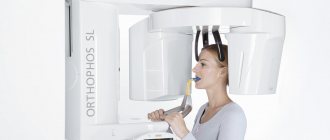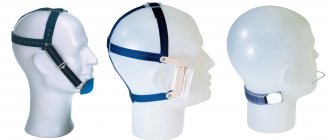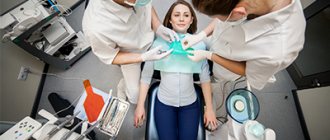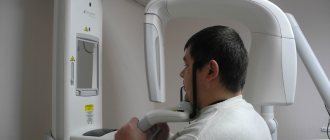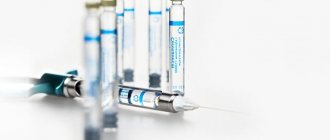A physiologically correct bite is the basis of not only a beautiful smile, but also the quality of the general condition of the entire body. Bite deviations can and should be dealt with regardless of the severity of the defect. Modern orthodontics can cope with any pathologies.
The Herbst appliance is a fixed orthodontic structure designed to correct distal occlusion (when the upper jaw is significantly larger than the lower jaw). Its use can be either an independent method of treatment or an additional means of correction.
Design features of the Herbst apparatus
As you know, distal occlusion is one of the most difficult to treat. This is due to deviations in the development of the entire jaw apparatus, and not just a violation of the position of the dental units.
The Herbst apparatus is made from individual casts of the patient’s jaw from titanium alloys and inert steel.
The design contains:
- two beams (telescopic, articulated, not hindering the natural movements of the jaws);
- four support crowns;
- metal rings for attaching beams to crowns.
Impression from the upper jaw
The specialist’s algorithm of actions includes 4 stages:
- The mouth opens wide and the spoon is placed on the high frequency. The displaced product is shortened behind the modular tubercle.
- Cheeks retract. The device is shed by the buccal cords, and its dimensions decrease near the sixth, seventh and eighth teeth.
- The upper lip is pulled down and forward. When the location changes, the device is shortened by about 3, 4 and 5 teeth.
- Pulling the lips forward with a long tube. Shortening is performed around 12 dental units.
The test is considered completed if there are no displacements. Fitting should be done carefully to prevent significant reductions in the basis boundaries.
Evaluating the results of the HF fitting allows the specialist to create an impression tray of the ideal shape. After adjusting the listed parameters, the dentist begins to form an impression.
Operating principle of the Herbst apparatus
A non-removable orthopedic design is a very active device in its effects.
This effect is possible thanks to its operating principle:
- round-the-clock operation of the device on the patient’s jaw;
- the principle of forced constant pressure on the ligaments and muscles of the dentofacial apparatus, allowing the correct position of the lower jaw to be taken and the growth of the upper jaw to be restrained.
Duration of treatment period
Changes in the patient's appearance occur in the first days after the installation of an orthodontic device.
It takes 4-12 months for the functioning of the joints, ligaments and muscles of the dentofacial apparatus to change. The duration of the treatment period depends solely on the age of the patient and the degree of complexity of the pathology.
Clinical and laboratory stages
After preparation and diagnosis, an anatomical cast is taken using standard spoons, assessed by a doctor and sent to the laboratory.
In the laboratory, a model is cast from an anatomical cast and an individual spoon is made on this model and sent to the clinic.
The doctor places an individual spoon in the mouth. In this case, the doctor performs Herbst tests (Figure 1)
on the upper jaw :
- Wide opening of the mouth - if the spoon moves, then it is necessary to shorten it from the zygomatic process to the maxillary tubercle (Fig. -1-b- (2))
- Suction of the necks - if the spoon moves, then it is necessary to shorten the edge of the spoon in the area of the cheek folds (Fig. 1-b (3))
- Pulling out the lips - if the spoon is thrown away, then you need to shorten its edge in the anterior section (Fig. 1-b(4)).
on the lower jaw :
- The patient swallows saliva - if the spoon is thrown off, then it is necessary to shorten the edge of the spoon from the place behind the tubercle to the mylohyoid line (Fig. 1-a-(1)).
- Slowly open the mouth - if the spoon is dropped, then it is necessary to shorten it in the area from the tubercles to the place of the future second molars (Fig. 1-a-(2). If the spoon rises with the front part, then it is necessary to shorten the edge of the spoon between the fangs (Fig. 1- a-(3)).
- The patient runs his tongue along the red border of his lips; if the spoon is dropped, then it is necessary to shorten the edge of the spoon, which runs along the maxillary-hyoid line (Fig. 1-a-(4)).
- With your mouth half-closed, touch your neck with the tip of your tongue. The mouth should be half closed. If the spoon moves, then you need to grind it on the hyoid edge of the spoon, moving 1 cm from the midline (Fig. 1-a-(5)).
- Touch the tip of your tongue to the tip of your nose. If the spoon moves, then it must be corrected in the area of the frenulum.
- Pull the lip forward - if the spoon moves, then you need to sharpen it again from fang to fang.
After carrying out Herbst tests, an impression is taken, which is called functional. When taking an impression, it is recommended to edge the edges of the impression to create compression.
Preparatory stage for installation of the Herbst apparatus
The complexity of the design requires special preparation of the patient for the installation procedure of the device.
To do this you will need:
- diagnose malocclusion using a comprehensive examination, including taking impressions, radiography, orthopantomogram, etc.;
- complete sanitation of the oral cavity (treatment of caries and inflammatory processes of the mucous membrane, professional hygienic teeth cleaning);
- preparation of upper molars and lower premolars for installation of supporting crowns on them;
- in the case of installing the structure on braces, telescopic beams are attached to their orthodontic arch using special centers;
- the final stage of installation consists of correction and adjustment of the telescopic mechanism.
Impression taking technique
Custom impression trays are created by a podiatrist in the dental office. The impressions obtained after the functional test are clearly aligned with the prosthetic fields. The product is pre-fitted.
Correction of the frenulum of the tongue, cheeks and lower lip is performed. Recesses are formed along the edges of the product. Depending on the location and size, the tubercles on the mucous membrane are closed completely or partially.
It is necessary to block the false mylohyoid lines and preserve the function of saliva drainage by Wharton's ducts.
During the manufacturing process of prosthetic products for edentulous jaws, potential changes in the structure of the gums are taken into account. To achieve reliable stabilization and fixation of orthopedic structures, it is necessary to obtain a clear image of the relief of the mucous membrane of the prosthetic bed. When making a dental tray for patients with edentia, the functional state of the soft tissues of the prosthetic field is taken into account.
When creating a prosthesis for toothless jaws, the tray is used as the base layer of the impression. Using corrective material of low viscosity, the doctor reliably recreates the relief of the mucous membrane.
Herbst tests are ineffective in cases of severe atrophy of the alveolar process. This is due to the fact that the methodology is standardized.
The material used to mark the boundaries of the print is plaster or silicone. Some dentists prefer silicone due to its plasticity.
Advantages and disadvantages of the Herbst apparatus
Despite the variety of types of modern orthodontic structures, the Herbst apparatus has a number of advantages that make it possible to successfully eliminate the most complex malocclusion pathologies.
These include:
- simplicity and reliability of design;
- high performance;
- due to the constant impact on the jaw, the therapeutic period of treatment is reduced;
- the adaptation period is practically absent;
- treatment of distal occlusion with the Herbst apparatus for children under 16-17 years of age, in some cases even replaces surgical intervention;
- the possibility of combining treatment with other devices and techniques;
- the enamel of multiple units of the dentition is not damaged;
- the design does not cause discomfort to its owner.
A few disadvantages include:
- quite large size of the device;
- low aesthetics;
- quite labor-intensive hygiene procedures.
Preparation for orthodontic treatment
After agreeing to undergo orthodontic treatment, impressions were taken, the necessary measurements, examinations, and consultations with other specialists were carried out. As part of the Dental promotion, the patient received professional teeth cleaning using the Air Flow method as a gift.
Before starting orthodontic treatment, it was necessary to cure caries.
The patient was able to undergo treatment for dental caries at the Dental Center. The presence of the necessary specialists in one clinic makes the process of orthodontic treatment more comfortable.
After preparing the teeth and all the calculations, Damon-Q braces were fixed on the teeth.
Retention period after treatment with the Herbst apparatus
The final retention period is no less important than the therapeutic period. Since the non-removable Herbst appliance, as a rule, copes with complex cases of occlusion, retention takes longer than usual (about two years).
After the active influence of the orthodontic structure on the patient’s dental apparatus, his ligaments and muscles, it is important to qualitatively consolidate the functional changes in the new bite.
It is recommended to use retention products about 20 - 22 hours a day, so it is better to choose permanent type retainers.
Teeth straightening
The first stage of orthodontic treatment is aimed at correcting the position of the teeth of the upper and lower jaws and normalizing the shape of the dentition. It was planned to align the crooked growing central incisor along the gingival edge, and after orthodontic treatment, restore it along the cutting edge.
With each visit, the improvement in the situation becomes more and more noticeable.
As a result of orthodontic treatment, the dentition is sufficiently expanded and the position of the teeth is aligned.
The patient visited the orthodontist every 1.5 - 2 months. The duration of the first stage is 6 months.
Aesthetic correction after orthodontic treatment
Since the front teeth were disproportionate in size, at the end of the orthodontic treatment, Dial-Dent restored the front tooth with light-curing material Estelite Sigma Quick (Japan). The dentist who performed the restoration of the front tooth is T.I. Matienko.
Final correction of the bite after removal of the Herbst appliance
After removal of the Herbst appliance, the patient wore orthodontic elastics to achieve more correct and tight interdental contacts. The duration of this stage was 6 months.
How is orthodontic treatment performed with the Herbst appliance?
Orthodontic treatment using the Herbst apparatus includes several stages. First, braces are installed on the teeth, and the shape of the dentition is normalized. Both external braces and internal braces can be used. After creating the correct shape of the dentition (about six months after installing braces), they begin to correct the distal bite using the Herbst apparatus.
Braces remain on the teeth. Special crowns are installed on the two upper and four lower chewing teeth.
With internal braces it looks like this:
Telescopic hinges are attached to the crowns. The Herbst appliance constantly holds the lower jaw forward and does not interfere with mouth opening and chewing.
Gradually, the work of the muscles and temporal joints is rebuilt, and the new position of the lower jaw is fixed.
Commentary by orthodontist O.A. Baranova: “Since when correcting a distal bite, a significant restructuring of the muscles occurs and the position of the lower jaw changes, I advise my patients to undergo a course of treatment from an osteopath, who will help the body adapt to new changes. With the participation of an osteopath, bite correction is easier, faster, and there are fewer relapses. The participation of a myofunctional therapist is very important, who selects a set of exercises for additional training of the muscles that hold the lower jaw. The participation of an ENT specialist is often required so that a person constantly breathes through his nose and closes his mouth, that is, constantly puts the lower jaw in the correct position. That is why Dial-Dent implements the concept of complex treatment. In the treatment of orthodontic patients, not only an orthodontist is involved, but also an osteopath, an ENT specialist, and a myofunctional therapist. After the treatment is completed, dental prosthetics or artistic restoration are performed, that is, the patient receives an ideal smile, and not just straight teeth.”
